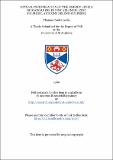Files in this item
Optical investigation of the energy levels of manganese in zinc selenide, zinc sulphide and zinc seleno-sulphide
Item metadata
| dc.contributor.advisor | Allen, J. W. | |
| dc.contributor.author | Leslie, Thomas Coutts | |
| dc.coverage.spatial | 170 p. | en_US |
| dc.date.accessioned | 2018-07-18T13:15:44Z | |
| dc.date.available | 2018-07-18T13:15:44Z | |
| dc.date.issued | 1980 | |
| dc.identifier.uri | https://hdl.handle.net/10023/15537 | |
| dc.description.abstract | This thesis describes the results of a course of experimental research into the optical properties of manganese impurities in the II-VI host lattices ZnSe, ZnS, and ZnSe[sub]xS₁₋[sub]x. These materials are of some commercial importance, since they exhibit electroluminescence when appropriately prepared. For this reason it is desirable to ascertain which inherent properties of the materials would determine device performance, and to try to distinguish these from apparently limiting criteria which are in fact cause by unknown and unwanted defects. Removal of such undesirable impurities may substantially benefit device performance. These materials are also of interest in that they exhibit some of the more complex properties of solids which can only be studied by the selection of a material which manifests the effects in question. That is, although the effects are studied in these compounds, it is to be expected that they will also occur more generally, although not perhaps as obviously. In order to fully appreciate some of the more complex effects which are studied, it is necessary to provide a substantial theoretical background. This is the function of chapters two, three, and four in this work. Chapter two is an introduction to the fundamental problem of transition metal impurities in solids, together with an indication of the approaches which have been made, and the approximation invoked. In chapter three the general problem of electron lattice interactions is discussed, with the aim being to offer an insight into the Jahn-Teller and Ham effects. Chapter four deals more specifically with the zero- phonon lines, including a mechanism which had hitherto received scant attention in this context. The details of the experimental apparatus and techniques are given in chapter 5, together with computational methods. Also included in this chapter is a method of determining mixed crystal composition, applicable to the ZnSe[sub]xS₁-[sub]x system which is much simpler than other techniques which have been employed. Chapter six reports the results of investigations into the zero-phonon lines in ZnSe:Mn. These results are interpreted in terms of the Jahn-Teller and Ham effects, and from the type of broadening mechanism invoked to explain the temperature dependence of the lines, a more accurate assignation of the energies of states split by the spin-orbit and Jahn-Teller interactions is made. The broadening mechanism invoked is of some importance, since it appears to have been largely ignored in studies on zero-phonon lines, although it is well known in those on spin-lattice relaxation. In chapter 7, the problem of non-radiative transitions in all three materials is studied, with the emphasis being on the limitations which they inflict on possible devices. Radiationless processes are considered first of all by investigating thermal dependence of emission intensity, and secondly by examining the effects of temperature on the lifetime of the excited state involved in the transition. It is demonstrated that the thermal quenching of luminescence is not an inherent property of the materials used, which had previously been suggested, but is dependent on the existence of some unidentified defect. Those chapters (i.e. six and seven) are essentially complete in themselves, including conclusions. In chapter eight, a brief, general summing-up is given, together with suggestions for some further work. | en_US |
| dc.language.iso | en | en_US |
| dc.publisher | University of St Andrews | |
| dc.subject.lcc | QD921.L3 | |
| dc.subject.lcsh | Crystallography | en |
| dc.title | Optical investigation of the energy levels of manganese in zinc selenide, zinc sulphide and zinc seleno-sulphide | en_US |
| dc.type | Thesis | en_US |
| dc.contributor.sponsor | Science Research Council (Great Britain) | en_US |
| dc.type.qualificationlevel | Doctoral | en_US |
| dc.type.qualificationname | PhD Doctor of Philosophy | en_US |
| dc.publisher.institution | The University of St Andrews | en_US |
This item appears in the following Collection(s)
Items in the St Andrews Research Repository are protected by copyright, with all rights reserved, unless otherwise indicated.

